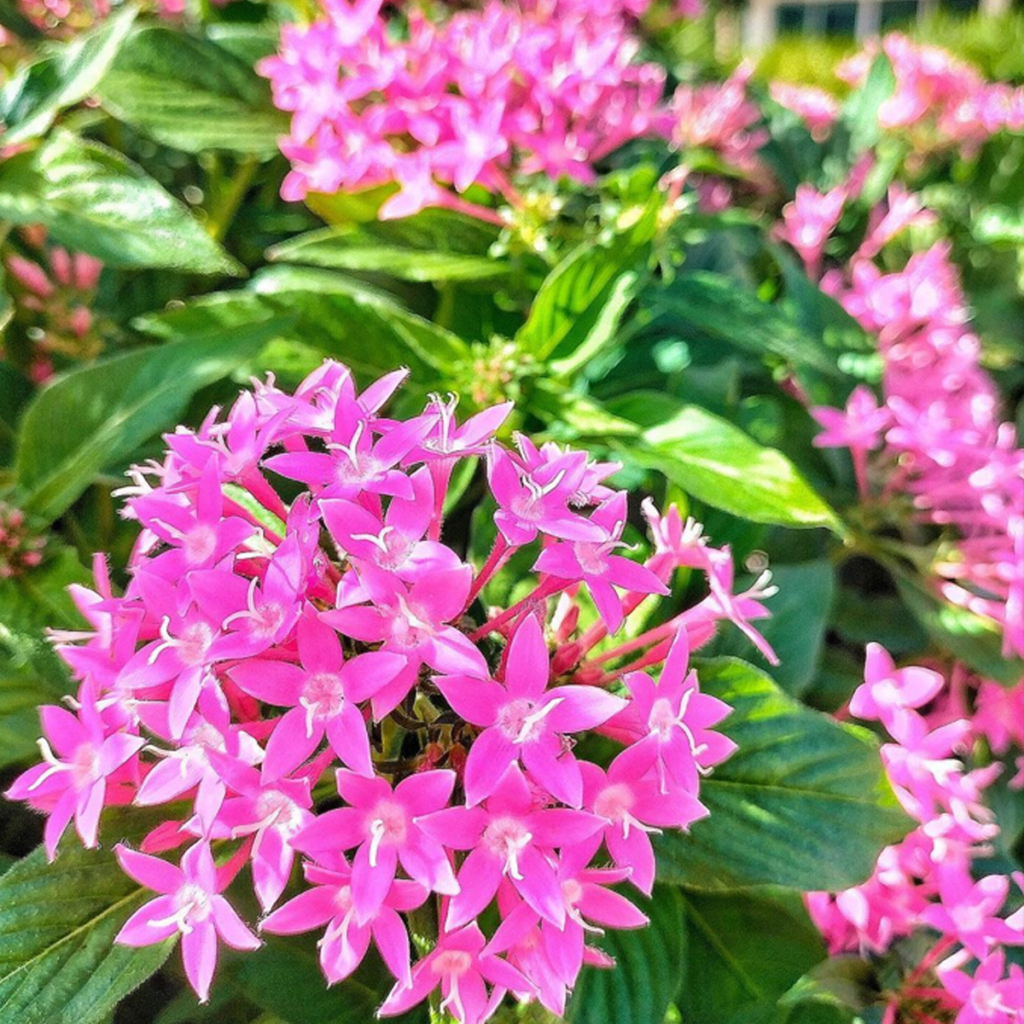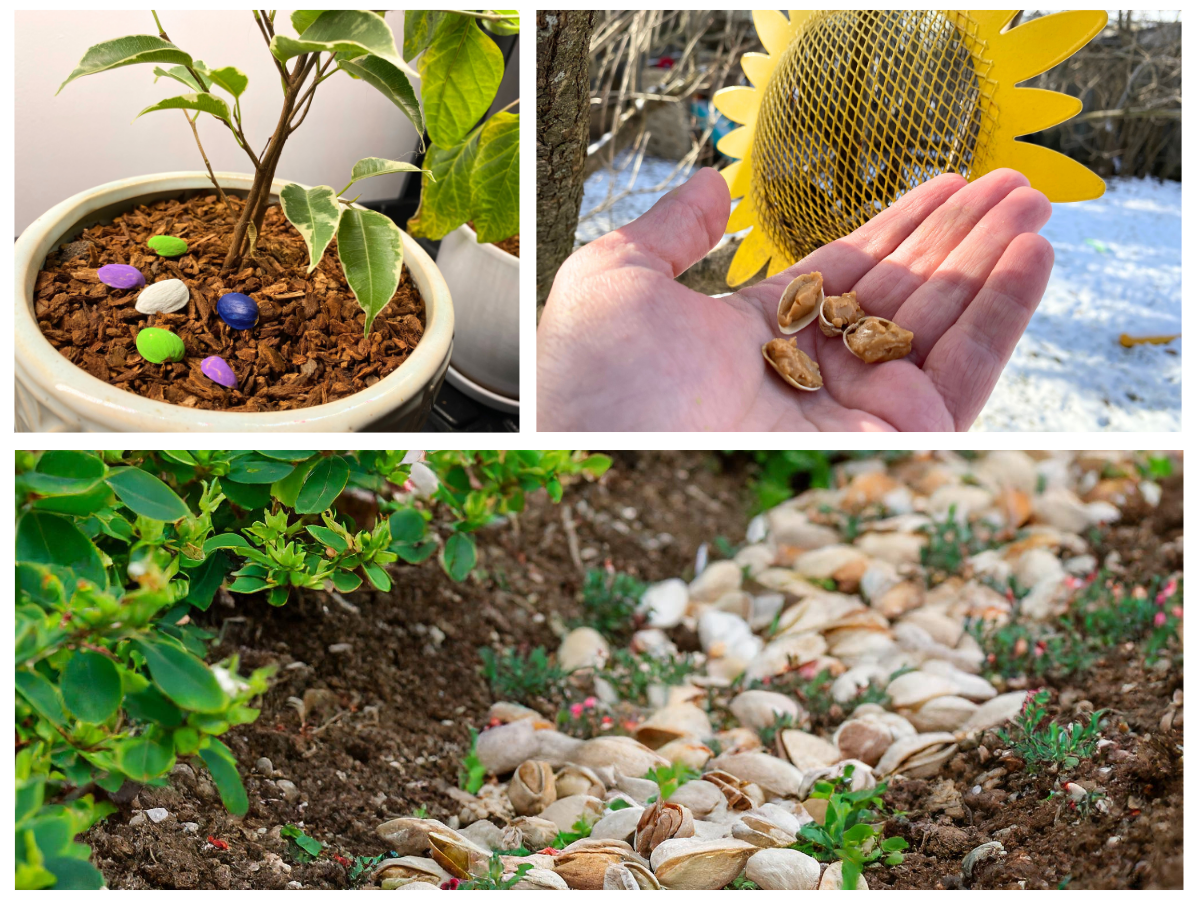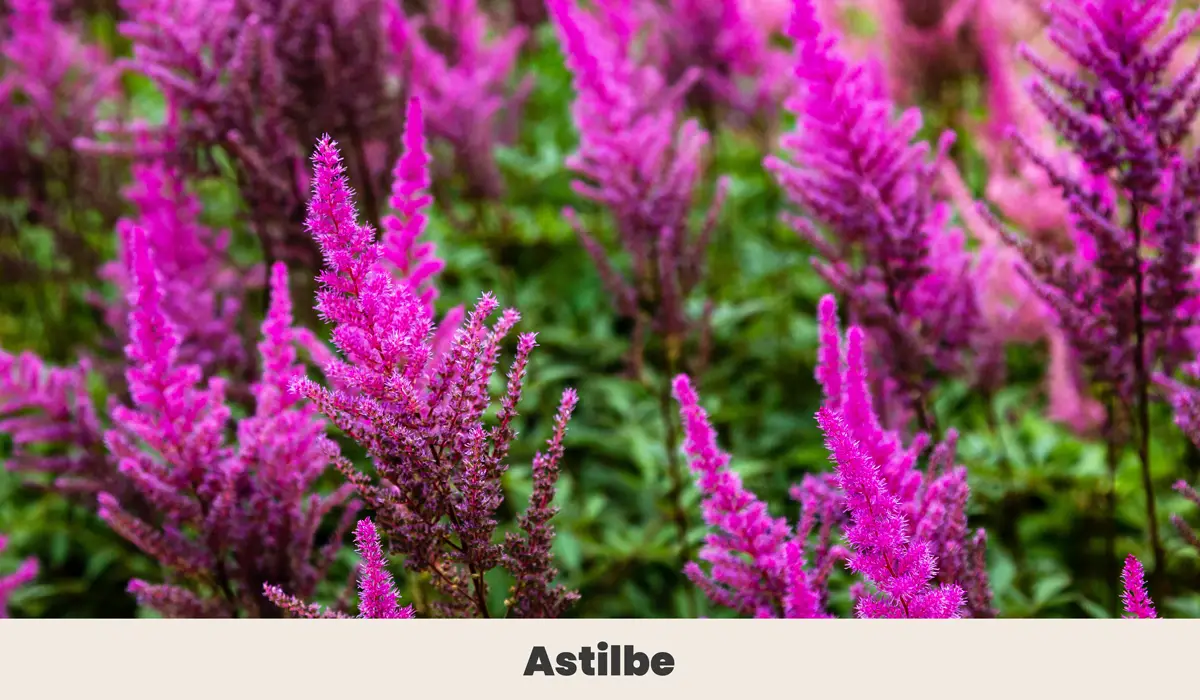11 Climbing Plants & Flowering Vines That Love Shade

Climbing plants and flowering vines make the perfect addition to your lawn and garden, mainly because they attract common pollinators, but because they’re pleasing to the eye, as well.
Whether you’re looking for vines that flower or hardy low light perennials, these plants are sure to spruce up your space.

Adding vines and climbing plants to my garden is something I truly enjoy. They not only provide visual interest, but also make it effortless to conceal any cosmetic flaws that I have yet to address.
Here’s a list of the top 11 climbing flowers and vines that grow in the shade and what you need to know on how to grow them best.
Trumpet Vine (Campsis radicans)

Trumpet vines are very easy to grow. With their beautiful red flowers, this North American native can easily add character to your garden. Though it tolerates partial shade, it will grow best when exposed to full sign.
Remember, the trumpet vine is a climber! So, to make sure it doesn’t take over your garden, regularly prune it in either the spring or winter to keep it contained.
Here’s a care guide on how to take care of this perennial vine:
| Botanical Name: | Campsis radicans |
| Growth Rate: | 10m tall and 2m wide |
| Native Range: | North America |
| Hardiness Zones: | 5-9 |
| Dangers: | Toxic, if ingested |
| Soil Needs: | Moist, well-draining soil |
| Exposure: | Partial shade or full sun |
| Ease of Care: | Low-maintenance |
| Diseases: | Leaf spots, powdery mildew |
| Propagation: | Divide in either the spring or fall after the pods are fully dried |
| Fertilizer: | Not required |
| Pests: | Whiteflies and spider mites |
| Blooming Period: | June-September |
| Pruning: | Prune the plant either in early spring or late winter to control its spread |
| Water needs: | Apply 1″ of water per week |
English Ivy (Hedera helix)

English ivy, which is also known as poison ivy because of the skin irritation it causes, is one of the most fast-growing plants around.
With their thick, dark green leaves, English ivy traditionally grows on lawns, around trees, and on the sides of either a house or trellis.
One of the things that people love about this shade loving plant is that it can tolerate a lot of soil and weather conditions. Here’s some helpful information on how to take care of these shade loving vines and plants that look like poison ivy:
| Botanical Name: | Hedera helix |
| Growth Rate: | Up to 32′ wide |
| Native Range: | Asia and Europe |
| Hardiness Zones: | 5-11 |
| Dangers: | Skin irritation |
| Soil Needs: | Loose, well-draining soil |
| Exposure: | Partial, bright, indirect sun and partial shade |
| Ease of Care: | Low-maintenance |
| Diseases: | Powdery mildew, leaf spots, and stem rot |
| Propagation: | Divide stems in late summer and place them in the soil with a bag over them; remove the bag once new growth emerges |
| Fertilizer: | Apply a nitrogen-rich fertilizer in the spring; do not apply it in the autumn or winter |
| Pests: | Aphids, caterpillars, loopers, and mealybugs |
| Blooming Period: | September – November |
| Pruning: | Trim as needed during mid spring |
| Water needs: | Water every 5-7 days to keep soil consistently moist |
Chinese wisteria (Wisteria sinensis)

With its cluster of purple flowers, Chinese wisteria is the kind of plant you would see in a storybook. Though some of the flowers on this plant are edible, the rest of the plant isn’t.
While you may you may be able to grow Chinese wisteria in shaded areas, it will reach it’s full potential in full sun.
Keep in mind that it can take up to 20 years for this plant to fully grow once planted from seeds. But when it does, you’ll be glad you planted it. This plant definitely deserves a spot in your garden.
| Botanical Name: | Wisteria sinensis |
| Growth Rate: | Up to 10′ |
| Native Range: | China |
| Hardiness Zones: | 5-9 |
| Dangers: | Excluding the flowers (sometimes), the rest of the plant is toxic |
| Soil Needs: | Moist, sandy soil with excellent drainage |
| Exposure: | Partial to full sun |
| Ease of Care: | Low-maintenance |
| Diseases: | Root rot and honey fungus |
| Propagation: | Divide softwood cuttings in either the spring or summer and hardwood cuttings in the winter |
| Fertilizer: | Not required |
| Pests: | Japanese beetles, spider mites, mealybugs, and aphids |
| Blooming Period: | Early to mid spring |
| Pruning: | Prune as needed to prevent overgrowing |
| Water needs: | Apply 1″ of water per week after planting; once established, water during droughts |
Climbing Hydrangea (Hydrangea petiolaris)

When in bloom, this hardy plant has beautiful white flowers. It’s also one of the most vigorous plants that love to climb, so be sure to give it something it can attach to. The best areas of your garden to plant climbing hydrangea include up against a fence or mailbox.
A climbing hydrangea usually develops flowers in the spring, but don’t be surprised to see this climber bloom well into the fall, too.
Here’s a helpful care guide about taking care of these fragrant white flowers:
| Botanical Name: | Hydrangea petiolaris |
| Growth Rate: | Up to 50′ tall and up to 6′ wide |
| Native Range: | Japan and Siberia |
| Hardiness Zones: | 4-9 |
| Dangers: | Toxic to wildlife |
| Soil Needs: | Moist, well-draining soil |
| Exposure: | Full sun or partial shade |
| Ease of Care: | Low-maintenance to moderate |
| Diseases: | Leaf spot and rust |
| Propagation: | Divide during early to mid-summer |
| Fertilizer: | Apply a 15-30-15 fertilizer once in the spring |
| Pests: | Spider mites and aphids |
| Blooming Period: | Late spring – late fall |
| Pruning: | Trim plant in mid-summer and remove dead branches any time of year |
| Water needs: | Apply 1″ of water to the plant per week |
Honeysuckle (Lonicera)

A honeysuckle plant develops interesting flowers that are very thin and long. In fact, these are flowers that look like fingers. Like most plants on this list, it is very low-maintenance and doesn’t require a lot of upkeep.
These are also very large plants and are able to grow up to 26 feet tall! This foliage prefers to be about in full sun and does not thrive in full shade.
If you’re looking to add pretty yellow flowers to your garden, check out the Honeysuckle! Here’s how you can take care of it:
| Botanical Name: | Lonicera |
| Growth Rate: | 13′ – 26′ tall |
| Native Range: | United States |
| Hardiness Zones: | 5-9 |
| Dangers: | Non-toxic |
| Soil Needs: | Well-draining soil with organic matter |
| Exposure: | Full sun – Part Sun |
| Ease of Care: | Low-maintenance |
| Diseases: | Crown gall, leaf blight, and powdery mildew |
| Propagation: | Divide between July and August |
| Fertilizer: | Apply a 10-10-10 fertilizer in the spring |
| Pests: | Caterpillars and aphids |
| Blooming Period: | Spring – mid-summer |
| Pruning: | Regularly prune in either late spring or summer |
| Water needs: | Water once a week; mature plants can survive in droughts |
Star Jasmine (Trachelospermum jasminoides)

This vine grows beautifully on fences and the sides of houses. It’s a real showstopper, too!
This vigorous vine does well in shady areas and, for the most part, can handle any type of soil including neutral, acidic, and alkaline conditions.
Here’s what you need to know about caring for these climbers for shade:
| Botanical Name: | Trachelospermum jasminoides |
| Growth Rate: | 3-6′ tall |
| Native Range: | Asia |
| Hardiness Zones: | 8-10 |
| Dangers: | Non-toxic |
| Soil Needs: | Moist, well-draining soil |
| Exposure: | Partial shade to full sun |
| Ease of Care: | Low-maintenance |
| Diseases: | Fusarium wilt, rust, and blight |
| Propagation: | Divide plant in the summer |
| Fertilizer: | Apply a 10-10-10 fertilize in the spring, after new growth emerges |
| Pests: | Whiteflies, red spider mite, and jasmine erophyid mite |
| Blooming Period: | Spring-summer |
| Pruning: | Trim overgrown branches in the spring |
| Water needs: | Water once a week |
Snail Vine (Cochliasanthus caracalla)

When the plant matures, it produces pretty lilac-colored flowers that will add a lot of beauty to your garden.
The great thing about this vine is that it is highly resistant to both pests and diseases. The only time it runs the risk of developing yellow leaves is if it is too exposed to sunlight and not properly hydrated.
If planted in full sunlight, you’ll need to water it more so it doesn’t die.
| Botanical Name: | Cochliasanthus caracalla |
| Growth Rate: | 15-20′ long |
| Native Range: | South and Central America |
| Hardiness Zones: | 9-11 |
| Dangers: | Non-toxic |
| Soil Needs: | Well-draining soil with organic matter |
| Exposure: | Partial – full sun |
| Ease of Care: | Low-maintenance |
| Diseases: | Yellow leaves |
| Propagation: | Divide plant in late summer |
| Fertilizer: | Not required, but you can add compost to encourage healthy growth |
| Pests: | Not applicable |
| Blooming Period: | Summer-fall |
| Pruning: | Trim new wood back in the spring and throughout the year to keep it contained |
| Water needs: | Water when the first 2″ of soil are dried out |
Yellow Passion Flower (Passiflora Lutea)

Are you thinking of adding some yellow passion flowers to your garden? This vine produces pretty yellow flowers that are likely to develop if the branches are hanging loose.
These are shade-loving climbers that also do well in full sun. It commonly attracts pollinators, including bees and butterflies.
Here’s an overview of how to take care of them if you decide to plant them in your garden:
| Botanical Name: | Passiflora Lutea |
| Growth Rate: | 10-20′ long |
| Native Range: | United States |
| Hardiness Zones: | 5-10 |
| Dangers: | Toxic to people and animals because their leaves contain cyanide |
| Soil Needs: | Moist, well-draining soil |
| Exposure: | Either full sun or partial shade |
| Ease of Care: | Low-maintenance |
| Diseases: | Alternaria spot and crown rot |
| Propagation: | Divide plant in the spring |
| Fertilizer: | Apply a 10-10-10 fertilizer in spring and every 4 weeks during the summer season |
| Pests: | Mealybugs, thrips, spider mites, and aphids |
| Blooming Period: | Late summer to fall |
| Pruning: | Not necessary, but you can prune anytime between late winter and early spring |
| Water needs: | Water every 9 days |
Pothos (Epipremnum aureum)

I personally love pothos plants because of how easy they are to take care of. It doesn’t take much for this vine to grow. All it needs is loose, well-draining soil and indirect sunlight to flourish.
What makes the pothos such a popular houseplant is that it does grow well in partial shade – and quickly! With the right conditions, it can grow up to 12″ longer per month.
This is a trailing plant, so feel free to have it in a planter that dangles from the ceiling or attached to your wall. You can expect it to grow anywhere from 4 to 30 feet (or more).
Here’s everything you need to know about this evergreen vine:
| Botanical Name: | Epipremnum aureum |
| Growth Rate: | Up to 12″ each month |
| Native Range: | Solomon Islands |
| Hardiness Zones: | 11 |
| Dangers: | Toxic to cats and dogs |
| Soil Needs: | Loose, well-draining soil |
| Exposure: | Medium, indirect sunlight |
| Ease of Care: | Low-maintenance |
| Diseases: | Phytophthora root rot |
| Propagation: | Divide plant during the spring |
| Fertilizer: | Apply a 10-10-10 or 20-20-20 liquid fertilizer once a month during the spring and summer; do not fertilize during the winter |
| Pests: | Mealybugs and scales |
| Blooming Period: | Grow between spring and summer |
| Pruning: | Not required |
| Water needs: | Water approximately every 8 days |
Bleeding Heart Vine (Clerodendrum thomsoniae)

Did you know that the bleeding heart vine got its name because of the flower’s small red center? This plant has flowers that hang down and look beautiful when they are grown up a trellis.
These vines love bright, direct sun because they are technically tropical plants but can handle shade without issues. You can expect to see these flowers from late spring and summer.
Here’s how to care for them:
| Botanical Name: | Clerodendrum thomsoniae |
| Growth Rate: | 10-15′ tall if grown outdoors |
| Native Range: | West Africa |
| Hardiness Zones: | 9 |
| Dangers: | Non-toxic |
| Soil Needs: | Rich, moist, well-draining soil |
| Exposure: | Direct sun |
| Ease of Care: | Low-maintenance |
| Diseases: | Wilting and yellowing leaves |
| Propagation: | Divide the plant between late spring and summer |
| Fertilizer: | Apply fertilizer in the spring at the start of the growing season |
| Pests: | Spider mites and mealybugs |
| Blooming Period: | Spring-summer |
| Pruning: | Prune toward the end of winter to encourage new growth in the spring |
| Water needs: | At least 1″ of water per week and only 2 times a month during winter |
Chocolate Vine (Akebia Quinata)

When these bloom, they produce the prettiest-shaped flowers that are a gorgeous mix between red, brown, and purple.
Believe it or not, it’s not the color these flowers come in that gives the chocolate vine its name; it actually has to do with the scent they produce, which smells like chocolate!
Grown best in hardiness zones 4 to 8, the chocolate vine does best when it has a mix of sun and shade. Since this is a climbing vine, it also does best when it has something to latch onto.
Here’s what you need to know about taking care of these flowering vines for shade:
| Botanical Name: | Akebia Quinata |
| Growth Rate: | 15-30′ long and 1-2′ wide |
| Native Range: | Asia |
| Hardiness Zones: | 4-8 |
| Dangers: | Non-toxic |
| Soil Needs: | Well-draining soil that is rich in organic matter |
| Exposure: | Partial shade or full sun |
| Ease of Care: | Low-maintenance |
| Diseases: | Not applicable |
| Propagation: | Remove cuttings at least 6″ long in the spring |
| Fertilizer: | Not required |
| Pests: | Not applicable |
| Blooming Period: | Spring |
| Pruning: | Prune evergreen climber back to ground level during the winter to encourage new growth in the spring |
| Water needs: | Water once a week while vines are being established, then add 1″ of water to vines once a week during droughts |
Final Thoughts
This plant guide can help you find the perfect climbing plants for shade. Whether you reside in hardiness zones 3 to 10 or zones 6 to 8, there’s a perfect flowering vine for you.
With this guide, you’ll know all the top tips and tricks for taking care of them.




